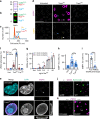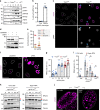Typhoid toxin exhausts the RPA response to DNA replication stress driving senescence and Salmonella infection
- PMID: 31492859
- PMCID: PMC6731267
- DOI: 10.1038/s41467-019-12064-1
Typhoid toxin exhausts the RPA response to DNA replication stress driving senescence and Salmonella infection
Abstract
Salmonella Typhi activates the host DNA damage response through the typhoid toxin, facilitating typhoid symptoms and chronic infections. Here we reveal a non-canonical DNA damage response, which we call RING (response induced by a genotoxin), characterized by accumulation of phosphorylated histone H2AX (γH2AX) at the nuclear periphery. RING is the result of persistent DNA damage mediated by toxin nuclease activity and is characterized by hyperphosphorylation of RPA, a sensor of single-stranded DNA (ssDNA) and DNA replication stress. The toxin overloads the RPA pathway with ssDNA substrate, causing RPA exhaustion and senescence. Senescence is also induced by canonical γΗ2ΑΧ foci revealing distinct mechanisms. Senescence is transmitted to non-intoxicated bystander cells by an unidentified senescence-associated secreted factor that enhances Salmonella infections. Thus, our work uncovers a mechanism by which genotoxic Salmonella exhausts the RPA response by inducing ssDNA formation, driving host cell senescence and facilitating infection.
Conflict of interest statement
The authors declare no competing interests.
Figures






Similar articles
-
DNA damage-induced RPA focalization is independent of gamma-H2AX and RPA hyper-phosphorylation.J Cell Biochem. 2006 Dec 1;99(5):1452-62. doi: 10.1002/jcb.21066. J Cell Biochem. 2006. PMID: 16927366
-
The Typhoid Toxin Produced by the Nontyphoidal Salmonella enterica Serotype Javiana Is Required for Induction of a DNA Damage Response In Vitro and Systemic Spread In Vivo.mBio. 2018 Mar 27;9(2):e00467-18. doi: 10.1128/mBio.00467-18. mBio. 2018. PMID: 29588404 Free PMC article.
-
Replication Protein A Availability during DNA Replication Stress Is a Major Determinant of Cisplatin Resistance in Ovarian Cancer Cells.Cancer Res. 2018 Oct 1;78(19):5561-5573. doi: 10.1158/0008-5472.CAN-18-0618. Epub 2018 Aug 2. Cancer Res. 2018. PMID: 30072396
-
[Replication protein A as a major eukaryotic single-stranded DNA-binding protein and its role in DNA repair].Mol Biol (Mosk). 2016 Sep-Oct;50(5):735-750. doi: 10.7868/S0026898416030083. Mol Biol (Mosk). 2016. PMID: 27830676 Review. Russian.
-
Functions of human replication protein A (RPA): from DNA replication to DNA damage and stress responses.J Cell Physiol. 2006 Aug;208(2):267-73. doi: 10.1002/jcp.20622. J Cell Physiol. 2006. PMID: 16523492 Free PMC article. Review.
Cited by
-
Replication protein A: a multifunctional protein with roles in DNA replication, repair and beyond.NAR Cancer. 2020 Sep 25;2(3):zcaa022. doi: 10.1093/narcan/zcaa022. eCollection 2020 Sep. NAR Cancer. 2020. PMID: 34316690 Free PMC article.
-
LACTB induced apoptosis of oxaliplatin-resistant gastric cancer through regulating autophagy-mediated mitochondrial apoptosis pathway.Am J Transl Res. 2021 Feb 15;13(2):601-616. eCollection 2021. Am J Transl Res. 2021. PMID: 33594312 Free PMC article.
-
MLH1 Deficiency-Triggered DNA Hyperexcision by Exonuclease 1 Activates the cGAS-STING Pathway.Cancer Cell. 2021 Jan 11;39(1):109-121.e5. doi: 10.1016/j.ccell.2020.11.004. Epub 2020 Dec 17. Cancer Cell. 2021. PMID: 33338427 Free PMC article.
-
Alpha-synuclein knockout impairs melanoma development and alters DNA damage repair in the TG3 mouse model in a sex-dependent manner.Front Oncol. 2025 Mar 20;15:1554059. doi: 10.3389/fonc.2025.1554059. eCollection 2025. Front Oncol. 2025. PMID: 40182046 Free PMC article.
-
Cellular Senescence in Immunity against Infections.Int J Mol Sci. 2022 Oct 6;23(19):11845. doi: 10.3390/ijms231911845. Int J Mol Sci. 2022. PMID: 36233146 Free PMC article. Review.
References
Publication types
MeSH terms
Substances
Grants and funding
LinkOut - more resources
Full Text Sources
Miscellaneous

